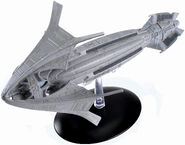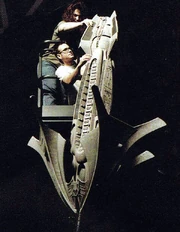(written from a Production point of view)

The Son'a collector
Until the re-imagined Star Trek film of 2009, Star Trek: Insurrection, tied with TNG: "The Best of Both Worlds, Part II", and Star Trek: First Contact, has been, after Star Trek: The Motion Picture, (holding the record with nine introductions), the Star Trek live-action production that introduced the most new ship and station designs at once, eight each, the Son'a collector being one of them. As with the other Son'a starships to appear in that movie, no description of the collector was given in the script, when it appeared for the first time in scene 128, merely mentioning that "THE FOUR SON'A SHIPS - (OPTICAL) dwarf the Enterprise as they move into orbit..." Nevertheless, there was one locked-in script requirement that set the collector apart from its Son'a counterparts as it specified in scene 248 that, "EXT. SPACE - BRILLIANT SOLAR SAILS begin to unfurl majestically in front of the planet's rings... and now we recognize it as the remarkable device we saw earlier in Ru'afo's simulation."
Design[]
The fact of the Son'a ships being very ambiguously described in the script left Illustrator John Eaves with considerable leeway to come up with his own designs for the vessels of a race that has not before been referenced to in the Star Trek universe, as was envisioned by his supervisor Herman Zimmerman, "John is such a talented man, I normally give him first crack at whatever the idea is that we've discussed with the director. He pretty much comes up with what he thinks that is, then we talk about it. The idea was to bring a kind of art nouveau sense into the Son'a ships, as if they were extensions of the organic Ba'ku culture that they have left, and, without actually giving that part of the plot away, give the subliminal feeling that these cultures were connected. That was really where we started with those designs, and I think John just did a wonderful job." (Star Trek: The Magazine Volume 1, Issue 2, p. 61)
Eaves, as the designated production illustrator, responsible for the design of the collector recalled, " All the Son'a ships are from activity games I found out in the backyard. I wanted to give a whole different kind of look to their architecture, so I kind of went with yard toys - Ru'afo's ship is based on a horseshoe, the battleship is based on a boomerang, the shuttle is a yard dart, and the science vessel ... well, the front of it is sort of a badminton shuttlecock turned inside out."" Another common design feature Eaves incorporated into all of his Son'a shops designs originated from the interior of a Grand piano, "[The ships] also have a kind of an inset detail that looks like a bunch of riblets; I based that on the strings inside a piano. I thought it would be fun to do that–their design is kind of like intricate wiring and framework, which is inset but open so you can see it. That was what I used as their kind of icon of design. It's on all the ships to an extent; you can see it extensively on Ru'afo's ship and the battleship, while the others had it inverted." (Star Trek: The Magazine Volume 1, Issue 3, p. 21) One of these "others" was the Son'a collector that did not expressively show the theme on the outside of the hull, but which he had, among others, incorporated in the otherwise barely seen inside of the collar assembly.
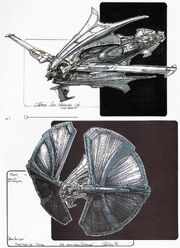
Eaves' March 1998 take on the design
Eaves started working on the vessel in March 1998, and his preliminary take on the design was quickly approved for further refinement. A noteworthy design feature was the dual collar assembly feature located at the prow of the vessel with its appendices dramatically flaring out. Mindful of Co-producer's Peter Lauritson predilection of having the Son'a ships flying with their appendices swept backward, Eaves designed the collector as such, unlike his previous designs for the Ru'afo's flagship model and Son'a battle cruiser model, whose flight directions he had to reverse on the producer's urging. Also in this stage, his design featured two fixed extended booms up front, from which the sails would deploy. "At that point we'd planned to have multiple wings unfolding and a forcefield acting as collector. This blue glowing field would then direct the methaphasic particles onto the sails. It would have been more a visual effect and less physically tangible." (Cinefex, issue 77, p. 88) Initially, Eaves intended the "multiple" wings to number three in order to break up the conventional Star Trek design style, but he was reined in by the producers who decided to go with two large sails. (Star Trek: The Magazine Volume 1, Issue 3, p. 23) There actually was a reason for this, as it turned out, because of the revised ending for the movie, as Eaves reiterated, "Also with the collector ship, we had giant fans that were gonna unfurl from the sides. And the ship was based on three-point architecture, where you had a top fin and two kind of dorsal flanking fins on it. And not to make it look too symmetrical when the blades opened up, we chose two, and they'd kind of fold out. And the design work on that had to be very critical, because toward the end of the film, there's a battle taking place inside of the ship and they're in the chamber that kind of goes right through the center of these two fins that open up. So what you see around in the set is the storage area, where those blades were conceived." (Star Trek: Insurrection (Special Edition DVD) special feature, "The Art of Insurrection") At this point in time, it was also decided to dispense with the fixed booms, and instead having them incorporated and deployed from the main body. This necessitated Eaves, wanting to retain the interesting looking collars, to re-designate them from sail armatures to engines. (Cinefex, issue 77, p. 88) Eaves has additionally stated, "With its sails foiled back the Son'a science vessel [being called as such in scene 246] has the shape of a badminton birdie that's been hollowed out. The outside is sectioned into threes, and it's hollow all around them, so if you look at closely, it almost appears to be a ship within a ship.", adding that with its sails unfurled it was "much like a giant TV dish" (The Secrets of Star Trek: Insurrection, pp. 92-93)
As designed, and later executed as CGI effect, the unfurled sails of the collector were very reminiscent of those of the Bajoran lightship (designed by Jim Martin and built as a CGI effect by John Knoll), for the Star Trek: Deep Space Nine episode "Explorers". This was not a coincidence, but intentional as Eaves recalled, "They wanted those same kind of sails", further stating, "The sails pretty much went through all the design processes over at Santa Barbara [the CGI house]. I think it's so lovely the way they fold out. That came from Santa Barbara." (Star Trek: The Magazine Volume 1, Issue 3, p. 22)
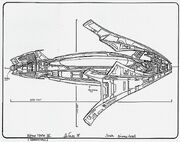
Eaves' side plan view for the Son'a collector
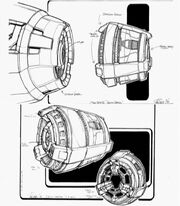
Eaves' escape pod designs
An different ending from the one that was featured, was originally envisioned for the movie, and which was partially filmed. In it, Ru'afo escaped from the collector by use of an escape pod, by Eaves simply referred to as "Ru'afo's pod". True to form, Eaves designed a collector escape pod for use in the movie. Eaves explained, "One of the big scenes we came up with was there's a pod. And it was a scene that was deleted from the final film. Bur Ru'afo is trapped on the collector when the rings are collected. And the way the scene is played, he's in this pod, gets shot out and kind of goes back in time, to almost nothing in the scene. And so we had to design this entire pod that would launch through the center of the ship, escape before it exploded, and eject into the rings. And that one, I think, we drew four or five different versions of it. And it wound up almost just being basically kind of an angled soda can. And it would eject out of the ship and you had windows all across the top so you could see kind of the aging transformation that would take place on Ru'afo as you can see where you're traveling through the open windows." (Star Trek: Insurrection (Special Edition DVD) special feature, "The Art of Insurrection") Yet, eventually an alternate ending was decided upon, making Eaves' work superfluous, at the eleventh hour. Nevertheless, first unit filming at the time, involving F. Murray Abraham, playing Ru'afo, had already been shot and the whole sequence was in an advanced stage of development, the sequence being geared for the addition of the visual effects. (Star Trek: Insurrection (Special Edition DVD) special feature, "Deleted Scenes") Eaves had the pod docked at the tip of the aft of the vessel, where he would later position the "injector launch area".

The injector mechanism launch as realized

Eaves' revised June 1998 design
The revised ending of the movie, necessitated further refinements on the design, something Eaves embarked upon three months later, in June 1998. For starters, Ru'afo's pod was replaced with the "injector launch area", comprising a whole aft section of the collector. Initially, Eaves intended the whole section, functioning as the injector mechanism, to be launched into Ba'ku's rings. (Star Trek: The Magazine Volume 1, Issue 3, p. 22) However, in the final version of the movie, the launch was only visualized in a long shot as a simulation, and the, what was called an "injector assembly" in scene 137, was toned down to a probe-sized contraption, apparently using the original design of Ru'afo's escape pod as a stand-in. Another noticeable design change Eaves performed, was the change of the asymmetrical dual collar assembly into a symmetrical triple one, thereby "sneaking in" his design preference he originally had for the sails. This time around, the configuration was followed through in the final representation of the vessel.
One continuing bone of contention was the size of the collector. John Eaves recalled, "For the Son'a collector, which was one of the ships that changed scales a lot through the drawing process, from being somewhere from two miles long to barely over 4,000 feet. And in the film it actually – You can see it from the opening shot, it's about the 4,000 feet. By the end of the movie you have the Enterprise strafing it, and it's almost back to the two-mile length. So, it was kind of fun watching that visually. And if you didn't know, you really wouldn't know. And the effects guys really carried that out well. I think Hunter/Grazner came and did giant miniatures for the explosion scenes in addition to the CG work." (Star Trek: Insurrection (Special Edition DVD)–special feature, "The Art of Insurrection")
Study model[]
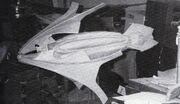
Jein's study model, ¾ front view
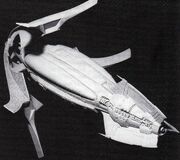
Jein's study model, ¾ aft view
While, the on-screen model was to be executed as a CGI model, Eaves' design was of such intricacy that a physical study model was called for, for the CGI modelers at Santa Barbara Studios (SBS) to mull over. The study model was built by long time Star Trek staffer Greg Jein. (Cinefex, issue 77, p. 91) John Eaves has elaborated, "The collector ship was based on the badminton birdie. It's almost like an umbrella with the ship inside the center of it. Greg Jein, one of the old model makers from The Motion Picture, came on. He built a couple of study models for it. And the model he built was this gigantic model, probably this long [note: spreading arms wide] and they had all intricate work on it, and they used that – Santa Barbara used a lot of the models he made for scanning, and did a lot of the work around that." (Star Trek: Insurrection (Special Edition DVD) special feature, "The Art of Insurrection") Afterwards, when additional visual effects work for the interior of the collector was called for, the study model was turned over to Blue Sky/VIFX, in order to match their interior work to that of the exterior. The model was based on Eave's earlier March designs and featured therefore the configuration with the asymmetrical dual collar assembly structure, instead of the symmetrical three collar structure as later adopted.
As Lot 3377 , the Son'a collector study model, including miscellaneous parts, measuring 33×7×7 inches, was sold in the It's A Wrap! sale and auction on 1 June 2007 for US$936.00 to American collector Eric Gunzinger. Included in the miscellaneous parts was a study model of Ru'afo's escape pod that Jein had already constructed as reference for the respective visual effects houses.
CGI model[]

Eaves' "disassembled" design sketch for SBS
The movie Insurrection, was the first feature film where it was conceived that all the visual effects would be executed as computer-generated imagery (CGI). At that point in time, the technique was still relatively new, and the workload entailed in creating these effects was such that it was decided to employ two effects houses for their creation; Blue Sky/VIFX, was contracted to provide all planet bound effects, whereas Santa Barbara Studios (SBS) would be responsible for all the space-bound visuals. Since the first visual in the feature of the vessel was an exterior one in outer space, the construction of the Son'a collector exterior therefore fell to SBS. SBS' Effects Supervisor John Grower stated, "John sent us elevation views and one or two ¾ perspective drawings of each ship, but we had to do a lot of deduction work. The Son'a Flagship and Battleships had very complex shapes and all of these incredible compound curves, which didn't appear in the plan views." As to underscore Grower's comment, Eaves produced an extra drawing as visual aid, apart from Jein's study model, for the modelers at SBS of the collector model to mull over, showing the collar assembly detached from the main body. Continuing, Grower added, "They're thin in one dimension and very wide and long in the other, kind of like a trilobite. The biggest challenge was that the Son'a ships didn't look the same from one angle to the next, so if we rotated around them a little bit, their profile changed because they had hundreds of compound curves that hooked together to form their shape. Getting it all to flow involved a ton of work and a very long modeling process." Apart from the intricate designs, creating digital ships on the computer was a labor, and time consuming effort from a technological standpoint as well, given the state of CGI technology at the time, as Grower further recalled, "Each ship was made up of lots of nurb surfaces, and the databases were hundreds of megabytes per ship. These models were very heavy, but Maya [remark: the CGI software package of choice at SBS] allowed us to efficiently structure and organize the data. We went through several iterations [of the ship designs] before we got approval, and Maya helped a lot there as well. Once we got the ships approved, of course, we had to make them look real." (American Cinematographer, January 1999, pp. 41-42)
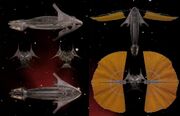
Orthographic views of SBS' finalized CGI collector model
The CGI sails of the collector were produced with "Cloth", an embedded software module within the Maya software package. Animator Mark Wendell recollected, "Some of the sail motion is based on a custom shader written by Ron Moreland, while other aspects come from the real dynamics you get with Cloth. The basic principles are similar to those in Dynamation [remark: a particle generator module in Maya] – a series of geometric vertices attached with spring calculations that apply to each specific vertex – and Maya has taken that spring idea from Dynamation and rewritten it to be more stable and less rubbery. But each patch of Cloth needed to be tacked at the edges, and the largest number of patches Alias/Wavefront [remark: the name of the company that owns and markets the Maya software] had ever tested was four – a shirt front, back and two sleeves. Since the sails needed to be attached between all the ribbed structural elements on the collector vessel, we used upwards of forty – we gave it a real workout." SBS textured the sails to resemble coppery-gold chain mail, but due to the long shots their surfaces came across as a continuous surface of grainy cloth. (Cinefex, issue 77, pp. 88, 90)
Though later referenced to in the Deep Space Nine television series and Star Trek Nemesis, the Son'a were never again featured visually, nor were any of their ships, so none of the CGI Son'a starship models were ever upgraded in the LightWave 3D CGI software for later representation. The CGI model though, was used as menu backdrops for disc two of the Star Trek: Insurrection (Special Edition) DVD. There actually was a reason for the later non-appearances of the Son'a ships, as Star Trek: The Official Starships Collection project manager Ben Robinson has indicated in 2015 that the original model computer files were no longer in existence, due to Paramount Pictures's failure to maintain ownership over these, as well as due to Santa Barbara Studios' own demise, "Never found the CG models from Insurrection... so we're rebuilding them! Makes me feel like Dan Curry." [1], he explained, "I'm working on this [remark: Son'a ships for the Collection] at the moment. It's tricky because the company that made the CG - Santa Barbara Studios didn't archive them and used their own software. Nothing is impossible though and I do have perfect reference [remark: referring to renders he had received for the Star Trek Fact Files years earlier]." [2] Still, Robinson considered the Insurrection designs too signature for them to be left out of his collection, and planned for their inclusion based on newly reconstructed CGI models, starting with two Starfleet ships featured in that film. [3]
True to his word, the issue for Son'a collector model was released on 17 January 2021, with the CGI model constructed in LightWave 3D – the software of choice of partwork publisher Eaglemoss Collections – by Fabio Passaro whom Robinson had assigned the task of reconstructing the Insurrection ships, [4] becoming the second of the Son'a ships to make a franchise reappearance after an absence of over two decades. Not only that, but the issue came with a display model, the newly constructed CGI model served as the template for.
Son'a collector break-away models[]
The less-than-stellar test screening of the footage of the original ending, to wit Ru'afo's escape in the escape pod, eventually led to a series of events resulting in the fiery destruction of the collector as depicted in the movie. Neither effects house was confident enough to execute the pyrotechnics heavy effects in CGI. While those effects, CGI explosions and fire effects, were by then already commonplace for the television franchise (especially in Deep Space Nine), that, however, given the state of the technology at the time, was not yet the case for big-screen motion picture productions, due to their higher resolution requirements at the time. It was then decided, at the eleventh hour, to execute those effects using traditional visual effects methods, through the use of pyrotechnics and break-away models. (Cinefex, issue 77, pp. 91-92)
Being outside their original assignment of having to provide CGI effects only, SBS was more or less at a loss. Though partner company Blue Sky/VIFX did maintain a physical model making shop at their east coast facility, which SBS did not; they were nowhere near outfitted enough to fulfill the eleventh-hour requirements asked for. So SBS passed that bucket to Hunter/Gratzner Industries (HGI), which was specialized in providing such services. CEO Matthew Gratzner recalled, "We got a call from John Grower asking if we could deliver a gray buck of the collector in two weeks. I figured we could give them something more that that – a hero miniature with plenty of detail. The powers-that-be at Star Trek agreed to let me storyboard and design the sequence – which was really a necessity, since I had to come up with miniatures that could actually be fabricated in the limited time available. I always say that visual effects are not expensive – it is the lack of decision-making regarding visual effects that is expensive. Since there wasn't any time for interference with the creative process – it was more a matter of "that sounds cool; go ahead ahead and do it" – we were able to finish on time. Picard is at the one end all the way to the other end of the ship through this vast interior as it starts to blow, with explosions coming towards him and the camera." (Cinefex, issue 77, p. 92) As to underscore the importance of the task at hand, SBS's Visual Effects Producer Bruce Jones also placed a call, as Gratzner recalled, "We got the call on a Friday from Bruce Jones, the visual effects producer at Santa Barbara Studios. He said, "Hey, we got this shot, what can you do in two weeks?" I said, "Send over your drawings of the ship.", because I knew nothing about the show or what this ship was supposed to look like. So, When Bruce Jones asked me what I could do in two weeks, I told him that he'd have to let us storyboard the sequence around what I knew we could build in that time frame." (Sci-Fi & Fantasy Models International, issue 35, p. 21)
Nevertheless, despite Hunter/Gratzner Industries's prowess as a visual effects company, some work had to be sourced out in order to meet the very tight deadline. For the providing of the master templates of his company's break-away models Gratzner turned to Innovation Arts, run by Paul Clemente. Gratzner had SBS sent them the CGI-files of the collector for them to cut foam master "bucks" for various parts of the ship, as well as molds made from them. Initially we were going to have sculpt and cast a pattern for this ship, but I'd have pulled all my hair out figuring a way to do this plus the big panel pieces. So I thought of Innovation Arts. (...) They've refined 3-D milling, routing and cutting to an art, and were able to take pared-down files for the collector from Santa Barbara, the mill, cut out and ship all the parts to us – turning the whole thing around in less than a week. The foam buck pieces were cut from six-pound urethane foam, which did not take long – reading the files actually took longer. Initially they were going to send those on to us for molding, but Paul Clemente offered to do the molds and the jackets there before shipping. They had to run twenty-four-hour shifts, but still delivered on time.", Gratzner reiterated. (Cinefex, issue 77, p. 92)
Son'a collector enlarged break-away panel models[]
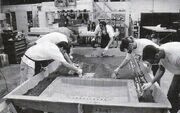
HGI's crew constructing a large panel casting
With the construction of the basic parts of the break-away models farmed out, and therefore for the time being out of the way, buying Hunter/Gratzner valuable time, that company could concentrate on constructing the large, 1/50 scaled, close-up break-away panels. "It took a day and a half to fabricate the pattern for these six-by ten-foot panels. There was a day to put it into rubber, and another spent making this huge, jacketed fiber-glass mold before we went on to casting, where two panels were generated per day.", Gratzner recalled. (Cinefex, issue 77, p. 92) He further stated, "We didn't have any finite details. We took the computer files, which, when enlarged, just looked like a 'patchwork of squares'. Since you never get that close to the ship, the best way that I could come up with was a design that looked Star Trek in appearance. It had a lot of oblique angles, not as rectilinear as Star Wars or as organic as Alien: Resurrection'. Without any time to do any research, we had to go with what I came up with." (Sci-Fi & Fantasy Models International, issue 35, p. 21) No less than eight 6×10 feet panels were constructed, each pulled from gigantic one-piece molds. The size however, caused some additional additional problems in that the fragile panel casts had to be delicately extracted by inverting them and let gravity help the rubber mold fall away from the casts. Gratzner explained,
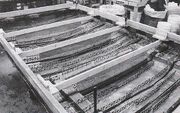
A reinforced large panel cast prepared for extraction
"We'd have six people running their hands against the edges for each part. Normally when you do jacketed molds, you can simply peel the rubber back, but the weight of the rubber would have caused it to collapse in itself. Around the perimeter we had also fiberglassed in a one-by-three wooden frame to provide structural integrity. The panels themselves – which featured key design elements from Greg Jein's maquette – were xceptionally well-detailed, with girderwork and trusswork beneath the surface so that when sections blew out there would be all this interesting material beneath that came into view. We used several different kinds of break-away resins, primarily one type that had the brittleness of plaster, but not the dust. For each take we utilized three of these panels end-to-end, which created a six-by-thirty foot section for each event." (Cinefex, issue 77, p. 92)
Onto the backsides, pre-cut at strategic points (aiding in keeping the debris small and in scale during the explosions) for easy disassembly when blown up, balsa stringers were attached for added support. Into those, resin trusses were placed, totaling around one hundred per each large breakaway panel. These would form under the surface skeleton, seen in silhouette through the fire. Detailing, to match the "checkerboard" grid as featured on the eventual full-scale break-away models, was comparatively easy, when it was applied by Model Maker Brian Ripley, and Model Painter Leigh-Alexandra Jacob.
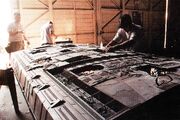
One of the panels being prepared by HGI at Van Nuys
Upon completion the panels were taken to the large Syncro Hangar at Van Nuys Airport, California, the location where the Chandler Group, a visual effects company specialized in motion control photography, had set up shop for filming by Tim Angulo and Don Baker. At the Chandler Group location, Ian O'Connor of O'Connor FX, a pyrotechnics specialty visual effects company that had already done a range of generic explosions on Insurrection for SBS, set up the pyrotechnics for the destruction of the panels, "Ian O'Connor put something like two hundred and forty hits in the eight foot model. Into the large breakaway panels he ran primer cord and charges everywhere along the undersurface.", as Gratzner recalled. (Sci-Fi & Fantasy Models International, issue 35, p. 21) He conceded that, "Originally, I thought the larger panels would be eliminated with primer cord, but Ian and Sherry wanted smaller debris and a whole sequence of blasts that utilized a kind of forced-perspective approach." O'Connor himself noted on his approach for the orchestrated pyrotechnics, he had developed but not used on an earlier project, Starship Troopers (1997), "There was such a limited time frame that we were only able to do one test on a full panel before we did the two big takes on the panel assemblage. We built a sub-frame for our forty-two internal mortars and various explosives, atop which we later set the large HGI panel pieces. We also built special channels with internal baffling that helped contain and control the progress of explosions. We plasma-cut them to make them look like internal detail pieces of torn steel for the collector – you can't be too careful about what might show up during a high-speed pyro shot." (Cinefex, issue 77, p. 92) During the set-up, Baker, Gratzner, and O'Connor hit upon the notion to open up small panels on the large-scale sections, pre-break them and loosely re-attach them onto the large pieces. O'Connor further elaborated,

|

|
"Sherry prepped the backs of the pre-broken panels on the large HGI pieces, using flammable material on some. These would fragment as they were blown up toward camera. Other pieces were treated with material that contracted when heated, so those would crumple and twist and melt while flying upward. They wanted the Enterprise flying right over thew explosions rather than sailing on in front of them, so that meant keeping the hits very small, flooding the panels with slow-burning composition that caused debris to come only a little bit – maybe twelve to eighteen inches – off the surface. Those fireballs couldn't go too far up though, because then they'd cross into the area occupied by the CG Enterprise during its flyover – which would have been a roto nightmare. So we had to orchestrate a number of tiny blasts that moved across the surface. We had secondary explosions going off underneath that added jolts and some interesting colors. As the blasts came closer to the camera, the events were spaced out a bit more, with the final six feet filled with primer cord to really demolish the thing. Between the foreground end of the model and camera, we put two big mortars that fired a big sheet of flame up under the lens, wiping the frame." (Cinefex, issue 77, p. 92)
Once all panels were produced, they were lined up to form a huge 6×30 feet slab. Three high-speed cameras covered the detonation from every angle. O'Connor's explosions in the feature swept down from the rear to the font, soliciting a remark of high praise from Gratzner, "Ian O'Connor pulled of some phenomenal stuff. He literally did "miniature pyro", producing fireballs that were eight or nine inches in diameter. On screen they looked thousands of feet tall." (Sci-Fi & Fantasy Models International, issue 35, p. 22)
Son'a collector break-away ship models[]
While HGI were finishing up on their panel section models, the preliminary parts from Innovation Arts started to come in, and the company had to turn their attention to the construction of that miniature. Due to the symmetric nature of the design, Innovation Arts only needed to construct one-thirds of each part. HGI followed the same pattern they had used on the large panel sections, fabricating molds and from them cast the parts they needed to construct the eight-foot long model. As a precaution and back-up they actually constructed two of them. Once pulled from the casts, the pieces received a preliminary paint-job, applied by HGI's modelers, among them, Brian Kelly Hahn, Tamara Waters, Forrest Fisher, and Michael Padilla.
Before final assembly, one of them was rigged with explosions by O'Connor, who admitted, "The eight-foot collector model had more pyro in it than I had ever stuffed into so small a space." (Cinefex, issue 77, p. 93) After the installation of the explosives, the model was assembled, and HGI's modelers finished up on the detailing at Van Nuys Airfield where its destruction was to be filmed by the Chandler Group.
Explaining how he designed the destruction sequence involving the 240 charges that went of like flashbulbs, followed by the four sequential large ring explosions, O'Connor continued,
"There were seventy-two wires feeding into the model – and they all had to be protected since the heat of one explosion could cut or melt wires and destroy the continuity of this forward-rippling blast. Because we cut from the tiny panels hits on the large-scale sections, there had to be a ton of microscopic events added to the eight-footer to link the shots. We divided the collector into nine zones of activity, knowing we'd have to match the continuity from the panel hits while taking the explosion from the collector nose and coming back. The first event rippling along the ship was a series of over-volted lamps that Sherry dipped in amber to get a quick colored flash. That led the destruction, with the event following behind it utilizing a new kind of two-inch charge we prepackaged to drop right into the back of the model after it had been drilled out. The third wave was a larger series of blasts – about softball-sized – devised by Sherry using benzoyl. She found a way to prepack them that also allowed us to propel them upward through the surface of the model. From there we went to the fireballs kicking the collector from within, while primer cord blew the whole thing to pieces." (Cinefex, issue 77, pp. 93-94)
O'Connors set-up conformed to John Grower's vision of the collector's demise as he has stated, "We wanted to show that it was blowing up from the inside out, so there were things coming out from off the surface, but at the end you want the whole thing to blow. And with that many timed events, and all their wires, you want to make sure one explosion doesn't set off some other one before it's supposed to. It took about 25 hours to actually load the model and test all the connections, to get it prepped to shoot – and then it's over in a split second. (...) And then we mixed the CG elements with the miniature work [the lamé-like sails and their burning disintegration were added by computer] and pumped it all together and they loved it – and that was all in the last week!" (Star Trek: Communicator issue 121, p. 58)
While the burning up of the sails were largely executed in CGI, some physical elements were required to match up the footage in post-production, as O'Connors explained, "We used a specially treated plastic film stretched over steel frames. The film was backed by pyro material, and we set the frame onto a latching box beneath that had fans and exhaust ducts built in. The pyro material on th back of the film was treated so we'd see some sparks and a bright burn suggesting the sails are some kind of exotic material. When we ignited the pyro, the fans extracted all smoke, so only the burn element photographed – creating something like the burning map of Nevada on Bonanza's opening credit. SBS put that right over its CG sails." (Cinefex, issue 77, p. 93) Matching all the physical model work with the CGI work in post-production, was something that was also foremost on the mind of John Grower who wanted to preserve all the interactive pyro lighting on the miniature. For this he closely coordinated with Don Baker to make sure the miniature lined up in a position that would match SBS' CGI model, "They shot it all anamorphic, so to save tome, instead of scanning at 4K and then squeezing, we scanned the squeezed image. We tweaked the position of our CG collector to correspond exactly with the miniature." (Cinefex, issue 77, p. 95) Debris flying through the sails were then added digitally, though lighting was all adjusted to conform to the real lighting originating from the O'Connor explosions.
Matthew Gratzner has expressed an exceeding satisfaction about the end result, "This is probably one of the most exciting pyro shots of any spaceship on film. It just goes on and on. There are so many incendiary explosions all the way through. It really scaled out beautifully." (Sci-Fi & Fantasy Models International, issue 35, p. 22) The sentiment was shared by original commissioner John Grower, who summarized, "There was a company back east called Illusion Artist [sic: Grower meant the aforementioned Innovation Arts] that was able to take our CG database and read that and cut that out of foam. [The science ship] was symmetrical, so they were able to do a third of the ship and sent it back to L.A., to Hunter-Gratzner, who we hired to do the miniature build, and they were able to [put it together] in record time – it was just amazing! So that miniature actually was the exact same shape and form as our CG model." (Star Trek: Communicator issue 121, p. 58)
In the end, HGI and consorts pulled of a minor miracle, as they had only two weeks, after receiving the phone call, to construct all the models, as well as an additional week for the pyrotechnics work, while SBS needed a further week to composite all the shots into the final footage. As it turned out, SBS handed in the final footage on schedule on 19 November 1998, a mere two weeks before the planned press screening. (Star Trek: Communicator issue 121, p. 58)
The shoot went so well that Peter Lauritson approved the first take of the shoot during the dailies, and the finished back-up model was not needed for an additional take, making it the only surviving physical filming model of Insurrection. (Sci-Fi & Fantasy Models International, issue 35, p. 22) Since then, the model has been in storage, neither featured in the 2006-2008 wave of Star Trek auctions, nor the various 2006-2012 Star Trek exhibitions, and has not been sighted publicly since its construction. Instead the model, having lingered in storage, was ultimately sold as an off-the-books follow-up sale to the above-mentioned "Jein"-study model auction winner, American collector Eric Gunzinger.
Son'a collector interiors[]
As stated, the aforementioned less than stellar proof screening of Ru'afo's escape scene, precipitated an alternate ending, involving the more spectacular destruction of the collector, and Picard's and Ru'afo's altercations within the collector, or as Blue Sky's John Kilkenny reiterated, "The whole third act had changed a lot from the time of our first bid, and then changed again prior to the film's release. Frakes and Zimmerman had been limited by the height of Paramount stages when building the live-action part of the collector set. That wound up being thirty-six feet high and maybe sixty feet across, so we extended its length to seemingly enormous proportions by adding a multitude of floors beneath the two figures." (Cinefex, issue 7, p. 91)

|
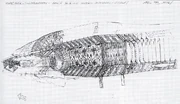
|
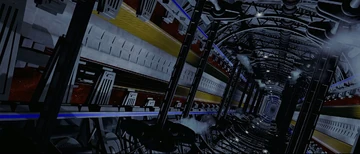
| |
Nevertheless, an interior was already envisioned in an earlier treatise of the script. As Blue Sky's Jim Key recalled, "Initially Carlyle had been given a cutaway sketch of the ship's interior that John Eaves had done a month before. It explained how the sails connected to the inside, as well as the main compartments. The only objection to it was the overall shape. Jim Rygiel and John Kilkenny wanted more of a true cylindrical shape to establish correct receding perspective. They also wanted scale items and mechanisms to enact movement on the sails when they were being deployed or gathered." Continuing, Key added, "During our opening discussions, Carlyle and I decided to make the interior a series of repeating truss sections, with gaps between each major area to open up the whole of the interior tube. This approach ensured a practical way of constructing the miniature and helped provide a clear internal vista to the camera, whether it be locked off or moving through the set. Our only other features were to install turning shafts that would crank down or raise the sails during the release or gather sequences, We even thought about the Collector, which would have resembled a huge tube with windings placed all around it, much like a generator with the armature removed." With everything in place, Key, in April 1998, set about to design the interior of the Son'a science vessel, "(...) the entire interior reminded one of looking down the inside of a dirigible, large enough to stow the Enterprise. With all of these drawings completed and layered together so that we could make a 'reveal' presentation, they were handed off to Peter Lauritson and rick Berman for evaluation. The response was positive – however, the price tag wasn't. Glorious as it was, it was simply out of the budget. Relegated to joining the CG roster, the interior would ultimately become a digitally created backdrop, handled in part by modeler Robert Rioux. Respectfully, we had signed off on it, thinking that was the last of the design work." (Sci-Fi & Fantasy Models International, issue 35, pp. 18-19)
Son'a collector injector assembly interior[]
- (under construction)
As it turned out, Key was proven wrong, due to the revised ending, and an interior design was deemed necessary for Picard's and Ru'afo's final confrontation, though in a setting that was nowhere near as grandiose an interior as what Key was originally tasked to visualize. Nevertheless, the setting, positioned within the injector assembly, proved to be daunting enough, as John Eaves recalled,
"When we were doing the injector designs, originally the ship is basically laid on a horizontal format. And so we were designing the set on that same type of format, where it was gonna be a long corridor as opposed tp a vertical one. And so, we had a model maker come in. He started all kinds of different versions of this open framework structure. First one was an original, it was a cylinder with two kinds of cylinders on the side, and you could do all your action crawling through these gantry ways and across he framework. As time went on, they figured we'll just go with kind of a gravity situation in the ship where it wouldn't matter which way it was angled, you can still manipulate the set. So they went with the vertical set, which was actually easier to build, actually easier for the cast and crew to work in. And so they built a single cylinder that was all based on framework. The model maker came in, built – like I said – he built many versions of the model And the final one was actually the simplest one that he had to do. We had another artist come in, Ray Harvie, who came in., and he basically storyboarded everything and he'd redo it every time the model changed.So he wound up doing boards – The same kind of action sequence based on these different sets over and over again. (Star Trek: Insurrection (Special Edition DVD) special feature, "The Art of Insurrection")
Further reading[]
- Star Trek: The Official Starships Collection, issue SP25, January 2021


